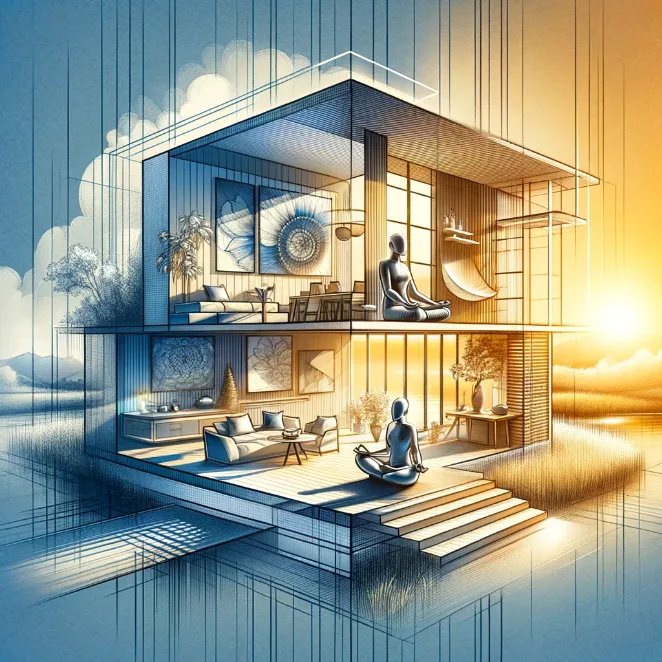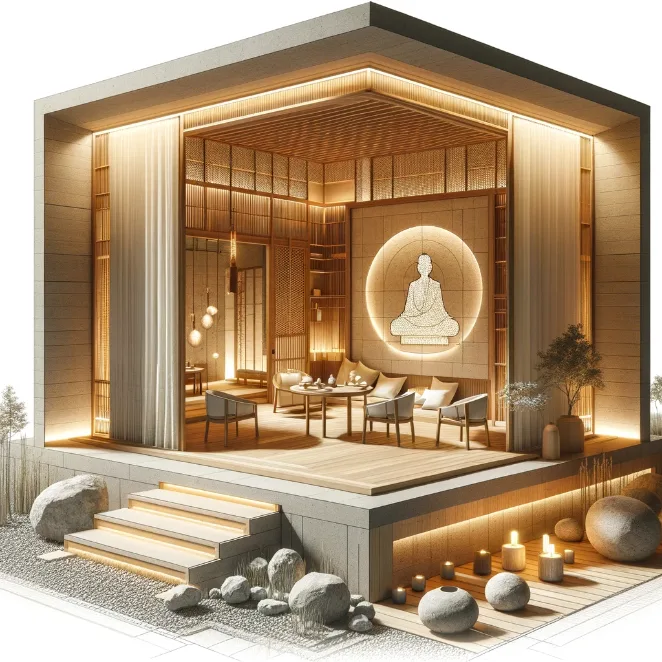
Creating Harmony Through Meditation In Architecture
In the realm of design, architecture stands as a powerful medium through which humanity interacts with its surroundings. From towering skyscrapers to serene temples, architecture shapes the physical and emotional landscapes of our lives. Yet, the relationship between architecture and human well-being goes beyond aesthetics and functionality. The incorporation of meditation principles into architectural design is a practice gaining recognition worldwide, as architects strive to create spaces that nurture not only the body but also the soul.
article by Hina Kurosawa
The Foundations of Mindful Architecture
In the world of architecture, aesthetics and functionality are two inseparable facets. Yet, architecture has often leaned towards the utilitarian, neglecting the profound impact that aesthetics can have on human well-being. The principles of meditation in architecture seek to strike a harmonious balance between form and function, recognizing that the visual and emotional appeal of a space significantly affects its occupants.
Architects now apply mindfulness in the design process, fostering an awareness of how spaces influence human emotions. Through meditation techniques such as visualization, they envision how people will experience their creations, considering factors like natural light, color, and spatial flow. This mindful approach allows architects to infuse their designs with an innate sense of tranquility, purpose, and beauty, elevating the quality of life for those who inhabit these spaces.

The Role of Nature & Sustainability
Meditation encourages a profound connection with nature and the environment, teaching us to respect and harmonize with the natural world. In architecture, this translates into a growing emphasis on sustainable and eco-friendly design. Modern architects embrace the principles of biophilic design, which incorporate natural elements into built environments.
Biophilic design goes beyond adding a few potted plants; it seeks to create immersive experiences with nature. Architects draw inspiration from meditation's reverence for the Earth, crafting buildings that seamlessly blend with their surroundings. Living walls, expansive windows that frame picturesque landscapes, and sustainable materials are all manifestations of this approach. By fostering a deep connection with nature, these designs promote a sense of serenity and balance.

Enhancing Well-Being Through Spatial Design
Incorporating meditation principles into architectural design extends to creating spaces that encourage introspection and tranquility. Meditation rooms, contemplative gardens, and sacred spaces within buildings are becoming increasingly prevalent in modern architecture. These areas provide refuge from the fast-paced world, offering a sanctuary for reflection and meditation.
The design of these spaces is carefully curated to evoke a sense of serenity. Soft, diffused lighting, natural materials like wood and stone, and minimalistic aesthetics create an atmosphere conducive to deep inner contemplation. Architects employ principles such as feng shui and Vastu Shastra, ancient practices that dictate how to optimize spatial energy flow, to enhance the spiritual quality of these spaces.

Where Architecture Meets the Soul
Meditation in architecture represents a harmonious fusion of ancient wisdom and modern design. It recognizes that the spaces we inhabit profoundly influence our mental, emotional, and spiritual well-being. Architects, by incorporating meditation principles into their practice, are shaping environments that go beyond shelter; they are creating sanctuaries that nurture the soul.
As this mindful approach to architecture gains momentum, we can look forward to living and working in spaces that not only serve our practical needs but also elevate our consciousness. The marriage of architecture and meditation reminds us that our built environment has the potential to be a source of solace, inspiration, and harmony—a testament to the profound impact of design on the human spirit.
Published: 12/1/2023
Modified: 12/1/2023
More predictions
Come back here soon to learn more about yourself and your future


Meditation & Quantum Physics
The realms of meditation and quantum physics may seem worlds apart, one delving into the innermost reaches of consciousness, the other exploring the fundamental nature of the universe at its smallest scales. However, a fascinating and profound connection exists between these seemingly disparate fields. In this article, we will explore the intriguing intersection of meditation and quantum physics, shedding light on the parallels, synergies, and transformative potential that emerges when we bridge these two domains.


Mindfulness-Based Stress Reduction Techniques
In today's fast-paced and often chaotic world, the importance of managing stress and promoting mental well-being cannot be overstated. One approach that has gained widespread recognition for its effectiveness in reducing stress and enhancing overall quality of life is Mindfulness-Based Stress Reduction (MBSR). Developed by Dr. Jon Kabat-Zinn in the late 1970s, MBSR has become a cornerstone of mindfulness-based practices. In this article, we will explore the principles and techniques of MBSR and its profound impact on stress reduction, mental health, and overall well-being.


Mindfulness For Life Coaches & Counselors
Life coaches and counselors play a pivotal role in guiding individuals through personal and emotional challenges. As the demands of modern life continue to increase, the need for effective tools and techniques to support mental well-being has become more critical than ever. One such tool that has gained significant recognition in the realm of coaching and counseling is mindfulness. In this article, we will explore the profound benefits of mindfulness for life coaches and counselors, shedding light on how this practice can enhance their effectiveness in helping clients navigate the complexities of life.